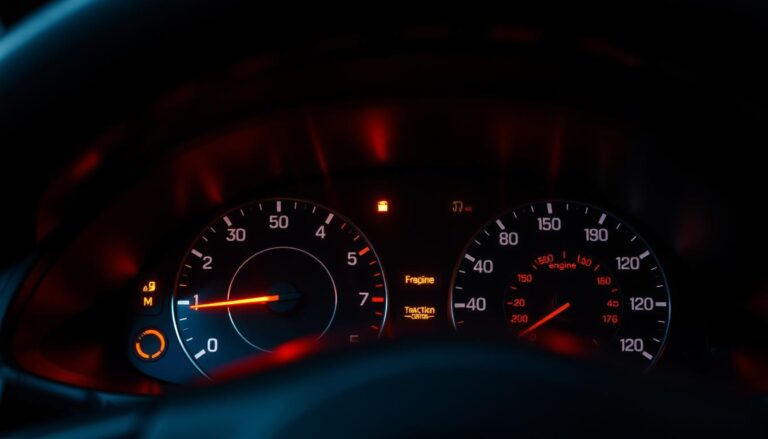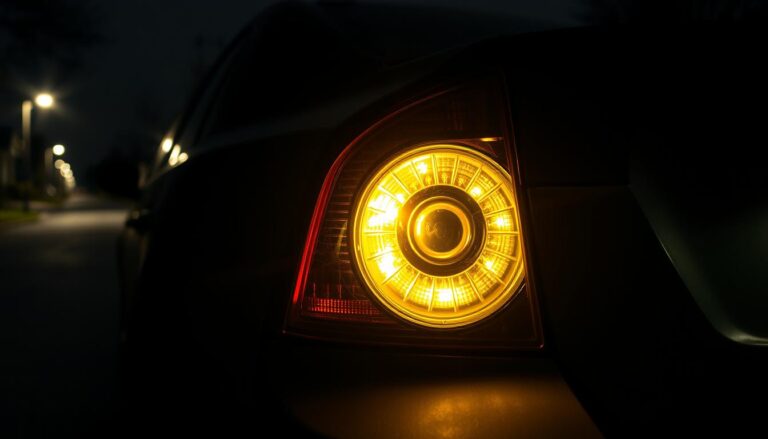This quick guide explains the orange/yellow icon that appears on many dashboards and how to respond. The light acts as a general warning symbol; the exact cause shows on the left-side message display.
Common triggers include low washer fluid or toggled traction control. You can scroll messages using the turn-signal stalk and often clear reminders after topping up fluids by acknowledging the notice.
Some alerts tie to the engine and the check engine light. Simple fixes, like tightening a fuel cap or correcting fuel grade, may let the light clear after normal driving. If the light blinks or the car runs rough, stop driving and call roadside assistance.
For DIY diagnosis, the OBD-II port sits in the driver footwell on the left. Hybrids and EVs may show a red triangle for electric drive faults and need certified service.
Key Takeaways
- Read the left-side message first to see the specific warning.
- Use the stalk controls to acknowledge and clear routine notices.
- Minor fixes often clear the light after driving; blinking or rough running demands a stop.
- Locate the OBD-II port in the left footwell for code checks.
- Electric drive faults require certified EV service if performance drops.
What the Volvo Triangle with Exclamation Point Means on Your Dashboard
An amber light is a general warning. Always read the left-side message display first to see the specific note. The display gives a short description of the affected system and any immediate step.
Common low-urgency triggers
Many of these alerts are reminders, not emergencies. Typical non-critical examples include low washer fluid and routine service prompts.
Using the turn signal to acknowledge messages
Scroll messages with the turn signal stalk. After topping off a fluid, tap the end of the stalk to acknowledge the note and often clear the light.
- Check the left message area to identify the issue quickly.
- Simple fixes usually clear the warning after a drive cycle.
- If the icon stays on after you act, review all messages—multiple notices can stack.
“Treat the indicator as a prompt to verify system status; many alerts are informational and cleared with a quick action.”
Volvo Triangle with Exclamation Point: What It Means and How to Fix It
Start by checking the message panel on the left side of the dash to identify the exact alert. A quick read lets you focus on the correct system and saves time.
Step one: acknowledge the message using the turn signal stalk. Tap the end of the stalk after topping off fluids; many owners report this clears routine notices.

Basic checks
If no message remains, top off basics like washer fluid. Then recheck the display and drive briefly to let monitors run.
Check engine context
For a check engine or engine light, verify the gas cap is tight and consider recent fuel octane. Tightening the cap and normal driving often lets the system re-test and the light turns off.
Diagnostic steps
Use an OBD-II scanner to pull codes before a service visit. The port sits in the driver’s footwell on the left-most lower dash.
Hybrid and EV note
A red triangle can signal electric-drive or high-voltage faults. If range or performance drops, contact a certified Volvo service center for safe diagnostics.
“Read, acknowledge, correct basics, then scan — document any return of the warning for the technician.”
- Read and acknowledge the left message area first.
- Fix basics like fluids and gas cap before deeper checks.
- Scan for codes and only reset Volvo codes after repairs.
Typical Causes Behind the Warning Light, from Minor to Serious
A single amber indicator can point at anything from a fluid low to a failing sensor. Read the dash message first to narrow the scope.
Minor causes
Small maintenance items often trigger non-urgent notices.
- Low washer fluid or routine service reminders.
- Traction or AWD toggled off will show a system note until restored.
- Temporary environmental conditions or a recent battery disconnect can also display lights that clear after a drive cycle.
Engine-related causes
When the vehicle shows drivability symptoms, suspect core engine components.
| Part | Common symptom | Quick action |
|---|---|---|
| Mass air flow meter | Hesitation or rough idle | Scan codes; clean or replace sensor |
| Oxygen sensors | Poor fuel economy, rich/lean codes | Check sensors; inspect wiring |
| Ignition coil / spark plugs | Misfires, blinking engine light | Replace coils or plugs; check harness |
| Catalytic converter | Loss of power, overheating | Diagnose backpressure; replace if clogged |

Fueling mistakes
A loose gas cap or low-octane fuel can trigger an evaporative or check engine alert.
Tighten the cap and drive; monitors will often clear the check engine light after a few cycles. Persistent faults need a scan of vehicle systems.
“Start with simple fixes, then scan—document any repeat warnings for the technician.”
Fix It Like a Pro: Quick Checks, Resets, and When to Visit a Volvo Service Center
A brief roadside check often spots the cause—look under the car, confirm the gas cap clicked, and note any switched controls. These quick steps solve many dashboard warnings without tools.
Quick DIY checks
Start by tightening the gas cap until it clicks and scanning for visible leaks under the vehicle. Verify you did not accidentally toggle traction or AWD buttons.
Reset basics
If the cap was loose or low-octane fuel was used, correct it and drive the vehicle normally. Monitors often complete and the light come off after a few drive cycles.
When to stop driving
If the engine light starts blinking or the car runs rough, stop driving to avoid damage. Call roadside assistance and arrange a tow to a trusted service center.
EVs and hybrids
Reduced range or persistent system alerts require a certified Volvo EV technician. High-voltage systems and specialized parts need trained service for safe repair.
- Use an OBD-II scanner to read codes; document findings before any reset Volvo attempt.
- Only clear codes after repairs so diagnostic data remains useful.
- Schedule a service centerschedule with your preferred Volvo service provider if warnings persist.
“Fix basics, record diagnostics, and call certified service when performance drops—timely action saves time and expense.”
Conclusion
Always start with the left-side readout; that short line guides your next move for safe driving.
Read, act, then verify. Note the message on the dash, perform simple checks like topping fluids or securing the gas cap, then drive a short mixed cycle to let monitors retest.
If the check engine light or engine light returns, plug an OBD-II scanner into the driver footwell for codes. That data helps decide DIY steps versus a visit to a local Volvo service center.
The workflow is the same for a Volvo xc90 or Volvo xc60, and for hybrid or EV cases where a red alert may indicate electric-drive issues. Keep records, follow service guidance, and stay current on inspections if you are on a lease.
FAQ
What does an orange/yellow triangle with an exclamation mark on the dashboard indicate?
The orange/yellow triangle is a general warning. Check the message display on the instrument cluster or driver information panel for a brief description. Often the message will point to a low-urgency item like fluids, a system reminder, or a feature status change such as traction control being toggled.
What are common low-urgency triggers for this warning light?
Typical low-urgency causes include low washer fluid, a scheduled service reminder, or temporary notifications from stability or driver-assist systems. These usually do not affect drivability but should be addressed at your convenience.
Can toggling traction or AWD features cause the triangle to illuminate?
Yes. Changing stability control, traction assist, or AWD modes may produce a warning message and light. Check the message center to confirm the specific system status before driving.
What is the first step to take when the triangle appears?
Read the message center and acknowledge the notification using the turn signal stalk or instrument controls. The message often tells you what triggered the warning and whether it needs immediate attention.
If no message appears, what should I check next?
Start with basics: top off washer fluid, verify doors and trunk are closed, and ensure any recent button toggles are reset. After correcting simple items, recheck the message display to see if the light cleared.
Could this triangle relate to a check engine or engine-management issue?
Yes. A related check engine condition can trigger a general warning. Common causes include a loose gas cap, incorrect fuel octane, or sensor faults. If the engine runs poorly or another engine light is active, treat it as higher priority.
How can I get diagnostic codes for the warning light?
Use an OBD-II scanner to pull stored fault codes. The diagnostic port is typically in the driver’s footwell on the left side. Reading codes helps identify sensors or systems reporting faults so you can decide on repairs.
Does the warning light signal different issues on hybrid or electric models?
On hybrid and EV models, a red or persistent triangle may indicate electric drive system faults, reduced battery range, or charging issues. These systems often require inspection by a certified service center experienced with electrified drivetrains.
What minor issues commonly trigger this light?
Minor triggers include low fluids, temporary system notifications, or traction control status changes. These are generally safe to drive with but should be resolved soon to avoid further alerts.
Which engine-related parts often cause warning messages?
Engine-related faults frequently stem from mass air flow sensors, oxygen (O2) sensors, ignition coils, or the catalytic converter. Any of these can set fault codes that prompt a dashboard warning.
Can fueling mistakes cause the triangle warning?
Yes. An improperly sealed gas cap or using the wrong fuel octane can trigger emissions or engine-management alerts. Tighten the cap and retest; if the light stays on, scan for codes.
What quick DIY checks should I perform when the light appears?
Inspect the gas cap for proper seating, look for visible fluid leaks, confirm doors and hatches are closed, and check recent button toggles that affect driver aids. Correcting these can often clear the warning.
How do I reset the warning after fixing a problem?
For simple fixes like tightening the gas cap, drive the vehicle for several cycles to allow the system to recheck. Only clear codes after repairs; using a scanner to erase codes without fixing issues can mask problems.
When should I stop driving and call for assistance?
If the light flashes, the engine runs rough, you lose power, or you see additional red warnings, pull over safely and contact roadside assistance or a service provider. Flashing lights often indicate serious faults that can damage the vehicle.
When should I visit a certified service center?
Visit a certified service center when fault codes indicate engine, emissions, or electric drive system issues, or if warning messages persist after basic checks. Certified technicians have the tools and training to diagnose complex systems.



